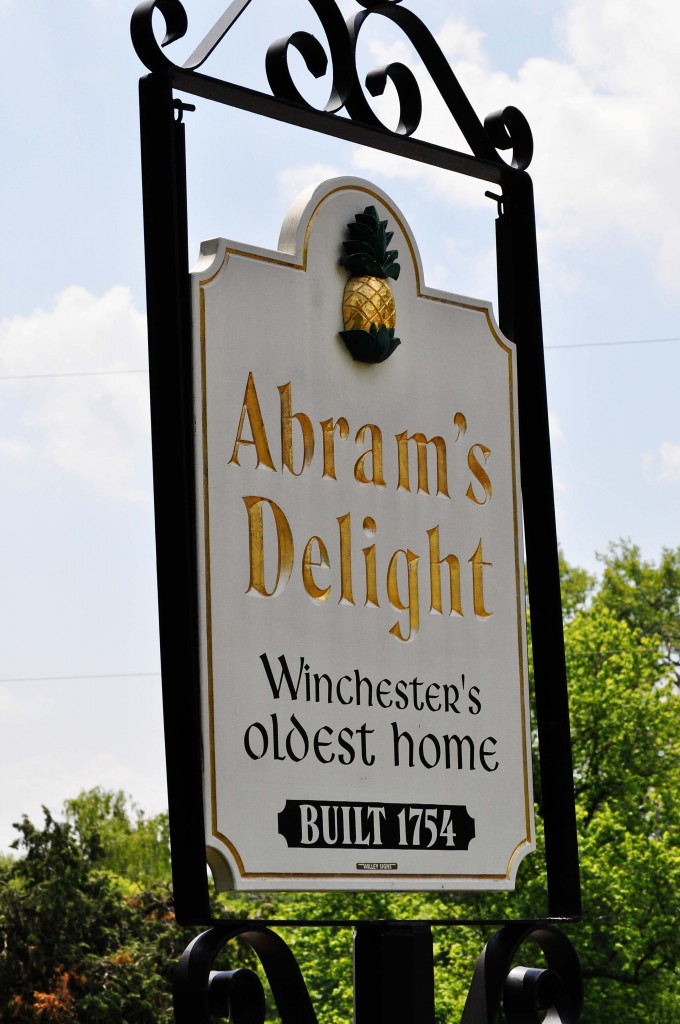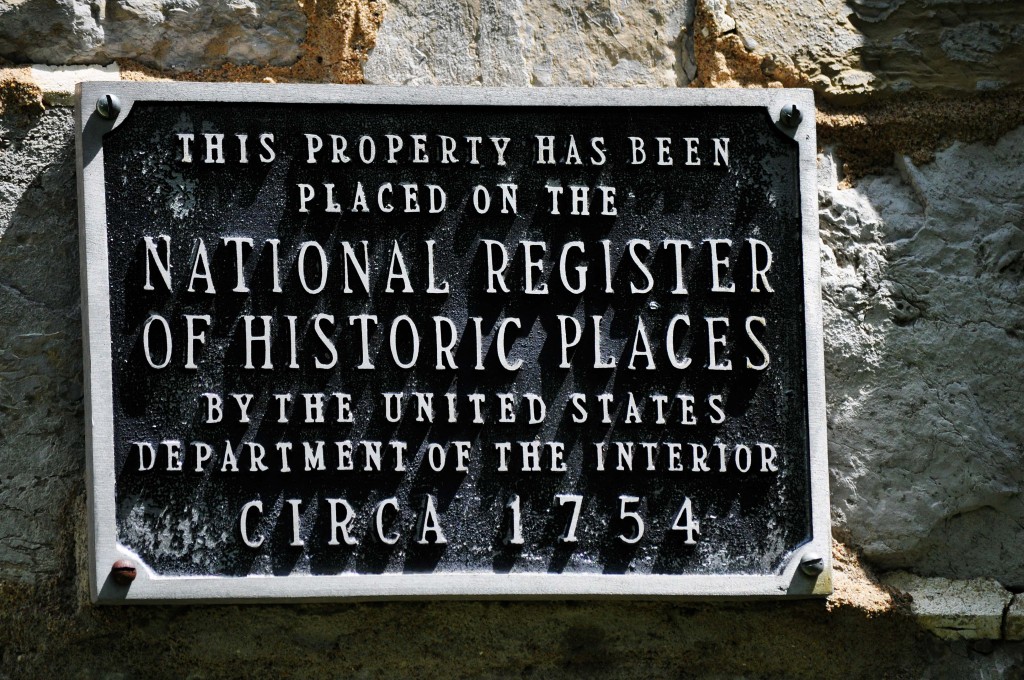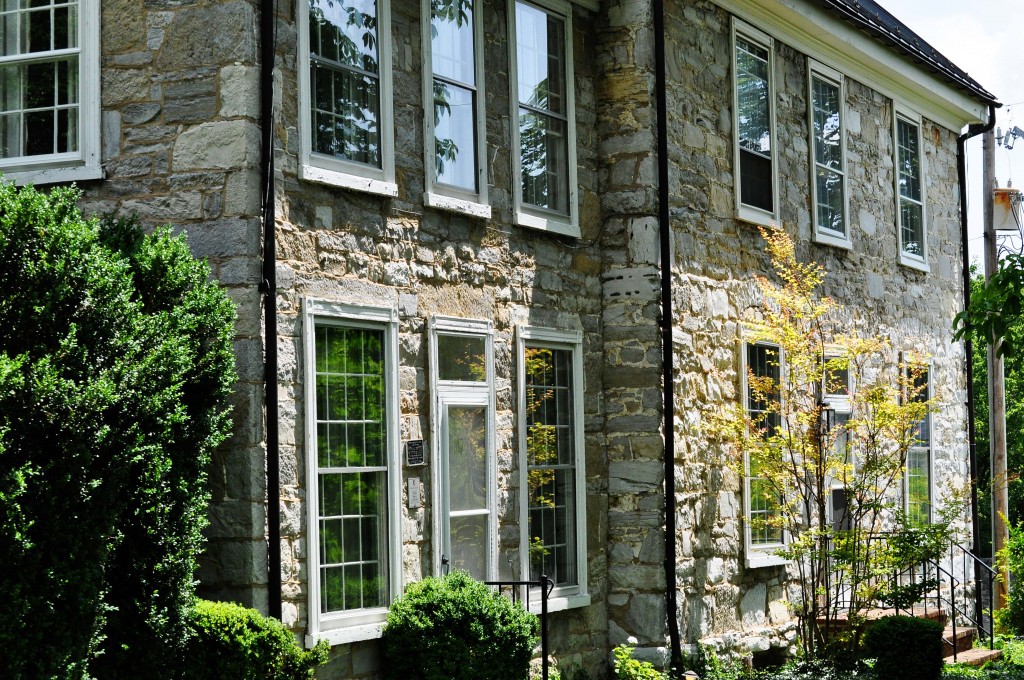My husband is descended through Abraham Hollingsworth, grandson of the immigrant Valentine Hollingsworth.
Since we were already meandering through Virginia, I decided to add a trip to Abram’s Delight in Winchester to our itinerary.
Here is what the Winchester-Frederick Historical Society has to say about the home:
““Abram’s Delight”, the site of five generations of the prominent Hollingsworth family covering 200 years, has a story of its own.
When Abraham Hollingsworth came to the Valley circa 1728, he was exploring, with the intention of finding a spot to build a home for his family and to establish a mill to supplement his income as a farmer. On this spot, he found the answer to his requirements – fertile land and an ample water supply.
After receiving a grant for 582 acres, his first dwelling was a log cabin located just to the west of the present house. The hand dug well included in the cabin can still be seen. It is believed that a wooden stockade surrounded the property and that several years before Abraham’s death in 1748 he began construction of the house as we know it today. Following the
death of his wife, Ann, in 1749, the property was inherited by the couple’s second son, Isaac.
Isaac was a leading member in the local Quaker meeting and planned his house so that it could be used for Quaker meetings. It was referred to as a “mansion” when compared to the log cabins in which his neighbors lived.
The builder, Simon Taylor, had completed “Springdale” in 1753. This was the home of another early settler, John Hite, and was located about five miles south of the Hollingsworth property. The stonework in both houses is very similar. Taylor’s skill as a stonemason still shows in the twenty-two inch limestone walls. While under construction, one wall in the house was made a movable one with hinges that could be raised and attached to hooks on the opposite wall. This made it possible to accommodate large crowds for meeting in this home (the largest building in the area) with men sitting in the parlor and ladies in the dining room.
When the house came into the possession of the third generation, adaptations had to be made. The new owner, Jonah Hollingsworth, and his wife Hannah, had thirteen living children and more space was needed. Therefore, around 1800, the west wing or reception room was added, using stone that closely matched that of the original house. He put dormer windows on both the north and south roofs so that his children could sleep in the “attic”, which was one large room on the top story of the home. He also added a portico (no longer standing) on the south entrance.
One of Jonah’s sons, David, acquired the house around 1830 and made many improvements. David, a prominent citizen, wealthy businessman, and community leader, was known for his love of entertaining and hospitality. We know that he moved the stairway from the northwest corner of the dining room to its present location in the hall. The west wall, which had been the moveable one, was made permanent. His most spectacular improvement was the construction of a large lake on the south side of the house, utilizing the plentiful water supply and increasing the water flow to his nearby mill. A summer house was built on an island in the lake and a fleet of boats carried visitors from the island to the shore.
David’s three children, none of whom ever married, inherited the property just two years before the beginning of the Civil War, an event which greatly affected these three members of the fifth generation of the family. As most properties of the area suffered from the many battles and changes of command, so did the “Abram’s Delight” complex. Following the deaths of Jonah Isaac and Mary (whom some considered a spy), only Annie remained in the old home. In her seventies, she soon made arrangements to leave. She promised to give her property to two cousins who lived in Winchester, if they would care
for her for the rest of her life. After an agreement was reached, she took her private possessions, closed the house, and left it unoccupied for almost 30 years.
In 1943, the city of Winchester purchased the old home and 35 acres of land for two reasons: to preserve the oldest home in Winchester and to protect the water supply provided by the Spring, which they leased for many years. A committee of the Winchester-Frederick County Historical Society with Mr. Irvan O’Connell as the overall chairman and Miss Mary Boxley in charge of the interior restoration, worked for nine years to restore the house. The house was opened as a museum in 1961.
A log cabin located on the west lawn dates to 1780 and was reconstructed on the premises in 1967. The cabin, located right across the west lawn of “Abram’s Delight”, is not Abraham’s but is similar to his. It is included with the tour of the main house.
I wasn’t sure what to expect when we were headed there. For some reason, I had pictured in my head that the house was going to be in the middle of a large field on the outskirts of town.
I was wrong.
Had I thought about it more, I would have realized that since it’s the oldest house in Winchester, it is actually in the middle of town. It’s just such a stark contrast to see such a historical building just down the street from a gas station and a strip mall.
I had originally planned on taking the whole family through the house, but when we arrived, I realized that wasn’t such a good idea. The home is a museum, containing many very old antiques. And most of them are out in the open.
I quickly changed my plans.
Andy waited in the car with the younger kids and I took the older 2 through the home. There was no photography allowed inside, but I got some pictures of the outside. Andy then took his turn and went through.





Even though the home actually belonged to Abraham’s son Isaac (and my husband is descended through Abraham’s other son George), I still thought that it was really interesting to see and well worth going a bit out of our way. 🙂






